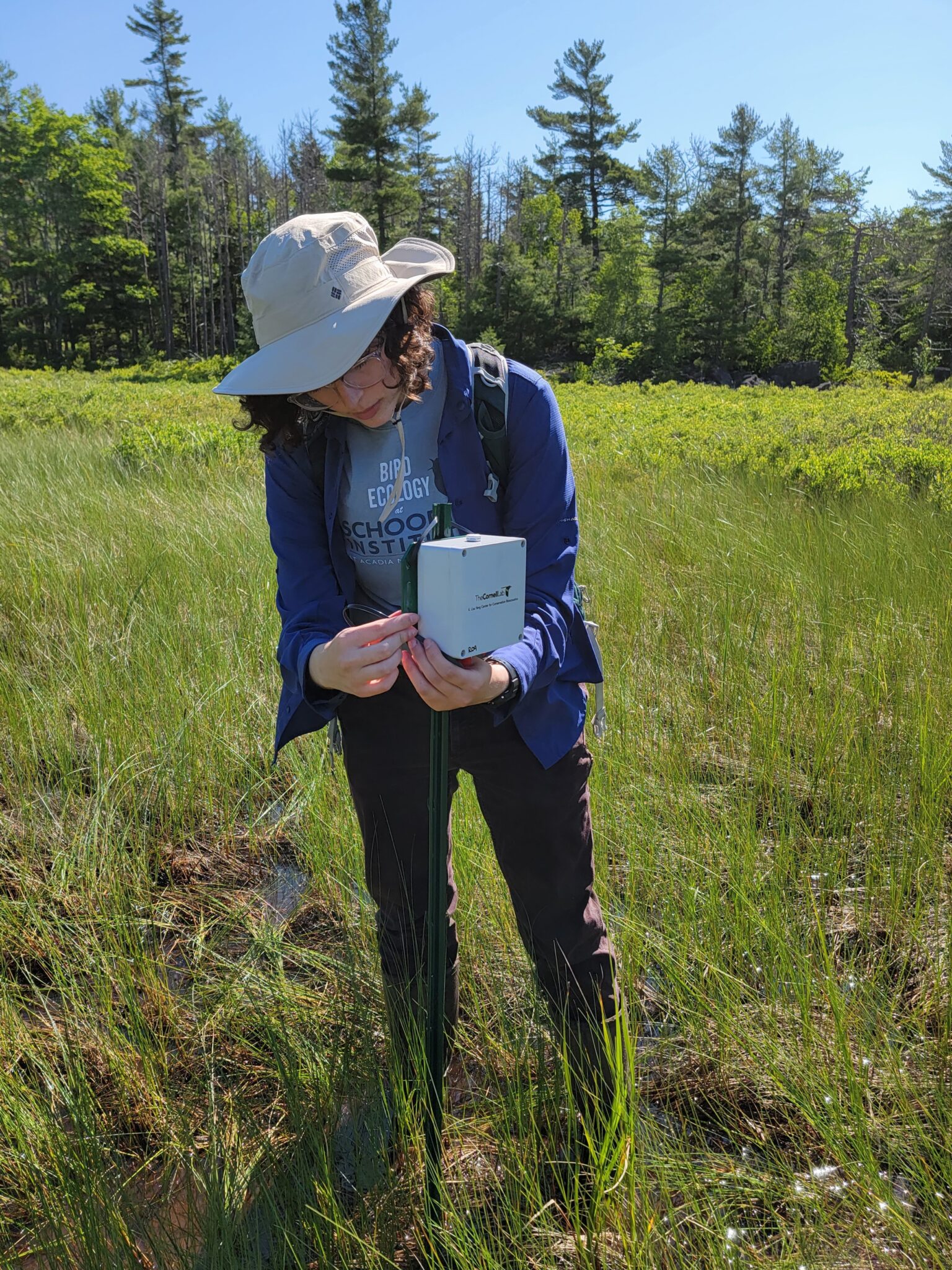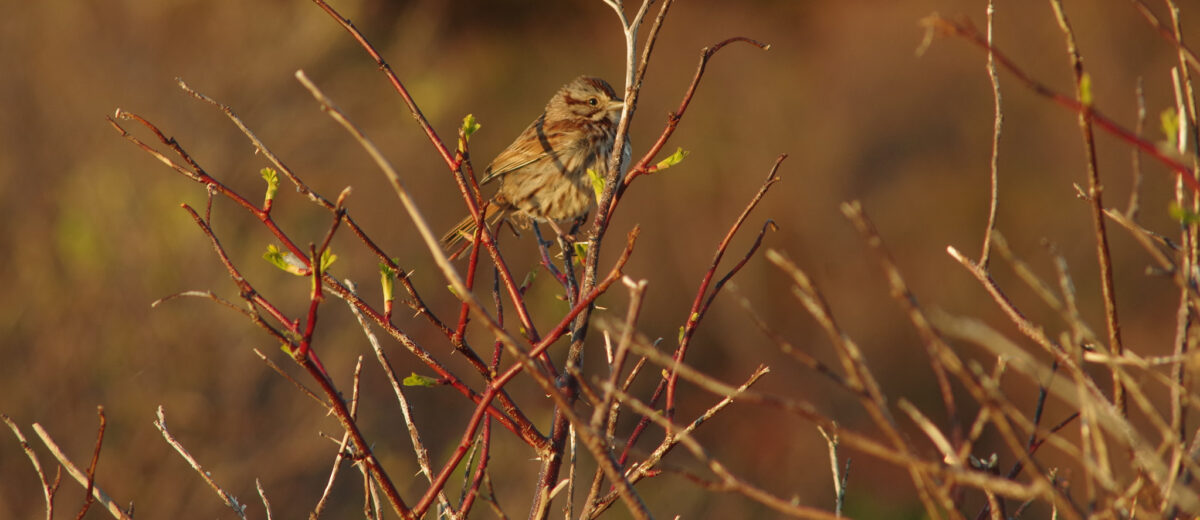by Brooke Goodman, Cathy and Jim Gero Acadia Early-Career Fellow
 I got interested in birds in high school. I lived near an Audubon-managed bird sanctuary, and was able to get an internship with that Audubon chapter. My interest in birds exploded. I became involved with my county’s annual Christmas Bird Count, and learned the value of long-term monitoring data for bird conservation. I went on to get my undergraduate degree in Zoology and Applied Statistics at SUNY Oswego. While getting my degree I worked in the Oswego Bird Behavior Lab, where we studied everything Northern Cardinals. I also spent a summer working for the Smithsonian Conservation Biology Institute in Montana, studying the breeding birds of the great plains. While out in those desert-grasslands, I realized something important about myself: I love living near water! That is how I now find myself at Schoodic Institute at Acadia National Park as the 2023 Cathy and Jim Gero Acadia Early-Career Fellow in Science Research.
I got interested in birds in high school. I lived near an Audubon-managed bird sanctuary, and was able to get an internship with that Audubon chapter. My interest in birds exploded. I became involved with my county’s annual Christmas Bird Count, and learned the value of long-term monitoring data for bird conservation. I went on to get my undergraduate degree in Zoology and Applied Statistics at SUNY Oswego. While getting my degree I worked in the Oswego Bird Behavior Lab, where we studied everything Northern Cardinals. I also spent a summer working for the Smithsonian Conservation Biology Institute in Montana, studying the breeding birds of the great plains. While out in those desert-grasslands, I realized something important about myself: I love living near water! That is how I now find myself at Schoodic Institute at Acadia National Park as the 2023 Cathy and Jim Gero Acadia Early-Career Fellow in Science Research.
One of my main motivators is bird conservation. Birds are in a tricky spot right now; a recent paper published in the journal Science found that 1 in 4 birds in North America and Canada have disappeared since 1970. This means drastic population declines across hundreds of species. These declines are happening for many reasons, but a main factor is the degradation, fragmentation, and loss of suitable habitat. Many humans are now looking to mediate environmental damage done in the past, but good intentions do not equal good outcomes. Ecological restoration is a relatively new field, and there are many opinions on what it means to “restore” something. No matter which way you interpret it, it is important to determine which methods are working for species recovery and which are not.
We need to be able to put numbers to the impacts our restoration attempts have on the organisms that currently or historically inhabited the land where we are working. It can be difficult to monitor these changes on the large temporal and spatial scales restoration often takes place over. The field of bioacoustics has an answer to this dilemma: passive acoustic monitoring! Passive acoustic monitoring is an emerging remote sensing technique which allows researchers to record the soundscape of an area for months at a time by deploying an autonomous recording unit. We can use this technique to quantify the response of the bird community to restoration efforts through their vocalizations.
Birdsong can tell us so much about the health of a habitat. From the presence of certain species we can infer what resources are available in an area, as different birds have specific needs for nesting, foraging, etc. We can understand the impact of restoration efforts on an area as the species composition changes, or remains the same, throughout the often decades-long restoration process. Passive acoustic monitoring allows us to identify the birds in an area using their song, and the sampling method is easily replicable year to year, avoiding the issues that come with the traditional point-count survey methods used for these types of projects. Though, a unique challenge does come with bioacoustics: how does one process thousands of hours of soundscape recordings?
You may be familiar with the Merlin Bird ID app from the Cornell Lab of Ornithology. The app’s sound ID feature uses machine learning, based on thousands of recordings in the Macaulay Library, to identify the bird species it hears when the user records the soundscape around them. Similar machine learning technology is able to process large volumes of acoustic data, greatly expanding the knowledge that can be gained from birdsong. We can use this technology, with human supervision, to quickly process our audio recordings and learn more about the species of birds in a given area.
We are taking these concepts and applying them to the restoration of the Great Meadow wetland in Acadia National Park. The hydrology of Great Meadow has been drastically altered by humans through the construction of ditches, roads, and improperly sized culverts, leading to flooding events. The recently passed bipartisan infrastructure bill provides Acadia the funding to replace the culvert at Great Meadow. It also provides funding to restore wetland plant life in areas where disturbance specialists and invasive species, which are better able to tolerate the altered hydrology, now exist. This summer we deployed recording units at Great Meadow, and also Gilmore Meadow, which will serve as a comparison wetland, since Gilmore Meadow maintains a more natural hydrology.
Now we begin to build the dataset that will eventually answer the question of how our restoration efforts impact the bird community at Great Meadow. This brings me back to why I do what I do. I love birds, and want to dedicate my career to figuring out how we can bring species back from the brink. Bioacoustics allows me to be part of an emerging field that may be key to the future of conservation. I love the constant development of new, innovative bioacoustics technology that allows us to ask and answer big questions, and save birds in the process.
